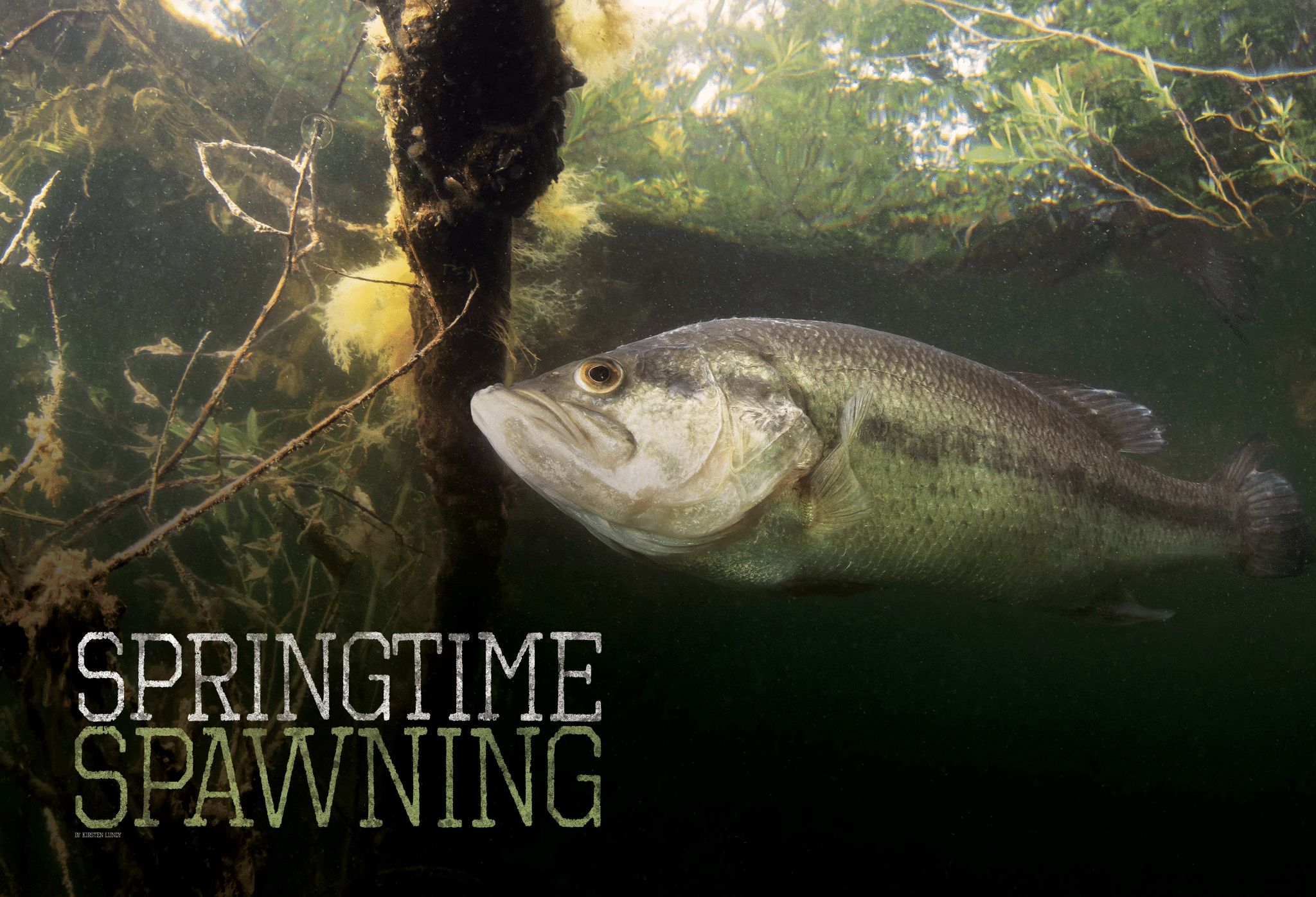Springtime Spawning

Springtime Spawning
Largemouth bass are a worldwide favorite sport fish, and, luckily for Iowans, they can find them all over the state. In fact, the Iowa DNR currently reports the presence of these bass in over 500 lakes and streams. So it comes as no surprise that warm temperatures lead many of Iowa’s dedicated fishermen to trade their ice shacks for jon boats in the hopes of pulling in a record hog.
Every year throughout the month of May, largemouth bass across Iowa enter the spawning season. This event is vital to the livelihood of the fish and can prove to be the most lucrative fishing season. Fishing for bass during this time period can be very rewarding as long as fishermen remain aware of their surroundings and the ever-changing temperatures. Various fishing practices will need to have implementations during each stage of the spawn. So, it is vital to know what the stages are and how to identify them. A fisherman who understands bass behavior throughout the entirety of the spawning season will be able to employ a successful technique that coordinates with the location and appetite of the largemouth bass.
Pre-Spawn
The Iowa DNR reports, “spawning starts in early May and lasts into June when the water temperature is 63 to 68 degrees.” This year, Iowans have seen some long-lasting extreme cold, so it is important to note the ideal spawning temperature may not arrive until later in the month. As long as the weather cooperates, water temperatures will begin rising in early May, thus triggering the male largemouth bass to begin their move into shallow waters in preparation of the spawn. If the air temperature remains low throughout the first week or two, fishermen should actively seek out shallow and murky bodies of water, for they will warm more quickly than deeper, clearer water bodies.
As the males begin their journey, you can find them in “transitional zones.” These zones can consist of anywhere between deep and shallow waters around some form of structure or cover. Steep drop-offs, shallow reefs, rock piles, brush piles, dock pilings, and densely vegetated areas will all be hotspots for male bass, whether they are attempting to fatten up in preparation of the spawn or have not yet begun spawning. Shortly after males, the female largemouth bass will emerge from the depths and settle in similar transitional zones as they wait for the construction of their beds.
As the month progresses and temperature increases, fishermen may begin to notice light colored disks about two to three feet in diameter often in no deeper than ten feet of water. This would be a bass bed, and if sighted, there is undoubtedly a male largemouth nearby. Even if beds are not visible, they will ideally be located in sunny spots with water depths of three to ten feet. These fish will be feeding aggressively to prepare for their period of fasting, so it is important to fish accordingly.
Regardless of whether a fisherman is focusing on bass in transitional zones, or bass migrating to the extreme shallows to begin bedding, the technique will remain the same. While slow-moving finesse baits can be an effective option during this time, reaction baits that are fast and erratic could yield a greater number of fish, as well as bass of a higher quality. Baits such as spinnerbaits, blade jigs, swimbaits, shallow crankbaits, swim jigs, etc., fall into this category and are a recommendation during this stage. The males will continue to feed aggressively right up until the arrival of the eggs.
Mid-Spawn
When a female happens upon a bed that she determines to be adequate, she will drop her eggs, sometimes even laying eggs on several different beds. Once all the eggs have been lain, the female moves back to deeper water. The fry can hatch as early as 24 hours later, although some emerge after an entire week. These hatchlings will stay in the nest for at least another week while the adult male stands watch. During this entire period—lasting two to four weeks—the adult male will nearly starve himself to ensure the safety of his young
While the fish may be less inclined to bite, they will be much more visible. They can often be observed in very shallow waters with amicable sunshine. This can be an advantage, but fishermen beware. Generally, if you can see the bass, the bass can see you. They will be on especially high alert at this time. When the bass are visibly nesting, the best course of action is casting directly on top of or through the beds, while also remaining out of sight.
If you see a nest, move a decent distance away, and then cast over it. The largemouth spook easily, so try to remain as inconspicuous as possible. Just because the beds are not visible, doesn’t mean they aren’t there, casting over sunny areas in the shallows can still prove effective. Many fishermen pull absolute giants off of beds that they were concealing themselves below the murky water.
Since the adult male has more than likely gorged himself in preparation of guarding the bed, fisherman often notice the fish bumping or nipping at baits, but not readily latching on. Although it can be difficult in practice, avoid setting the hook too early. These bass are in watch mode with their top priority being protection of their young. Wary bass may try to modestly scare off potential predators before resorting to an eventual solid bite.
In order to take advantage of this natural defensive instinct, fishermen should use baits that look like predators of eggs and small fry. Baits like Texas-rigged soft plastic creature baits, specifically, lizards, crawfish imitations, beavertails, etc., would perform well during this time along with similar finesse baits like Ned rigs and Niko rigs. Additionally, small swimbaits could also be viewed as a threat to the eggs and may be met with strong reactions from the largemouth. As far as determination of a technique, discern that most bass may not see a lure passing by as a threat that needs attention.
A sufficient method that will produce the desired reaction from the bass would implicate a cast that is precisely overtop of the bed. Following the cast, allow the bait to sink completely to the bottom. Once it hits bottom, reel in, and try again, continuous efforts will eventually aggravate the bass enough to where they come after it. Fishermen who are targeting bass on beds should keep in mind that these fish are to be released as soon as possible, as it may be vital to the survival of their young.
Post-Spawn
Following the spawn, the male and female largemouth will, for the most part, be found in completely separate locations. Females depart from the bed immediately after the eggs have been lain, while males linger near the beds even weeks after the fry have hatched. The females are the real trophies, so finding them before they head back to deep water is key. Similar to pre-spawn males, the females can be spotted in transitional zones or drop-offs in search of sustenance. The female bass are famished after the daunting task of laying eggs and will be actively feeding on their journey back to the deep water. When pursuing these females, similar to techniques used in the pre-spawn stage, it is beneficial to use fast-moving lures that produce a commotion.
Post-spawn, bluegill are notorious for utilizing the vacated beds of other fish, especially bass, for their own spawn. In turn, male largemouth bass will remain nearby to prey on the eggs, fry, and even the adult bluegill themselves. Once again, these males will be ready to refuel and will strike at any prey of ample size. Fishermen can take advantage of these bluegill beds by dragging either finesse or reaction style lures through them. Another tactic that promises results is the use of baits and lures with bluegill-like colors and patterns.
Anyone who has trouble determining exactly where the fish are at in their reproductive cycle should refer to the fishing reports provided weekly by the Iowa DNR. The reports can contain updates about the progress of the spawning season, which can be beneficial for those who have trouble finding fish. Though these reports can be extremely useful, keep in mind that by the time they post an update, the bass may continue on to another stage in the spawn.
If there is any question as to what stage the largemouth may be in, head back to the previously discussed transitional zones. These areas usually consist of some sort of drastic change in the underwater environment and can be home to largemouth year-round. Any bass in these zones should respond well to a reaction-style lure such as a crank bait. Overall, fisherman who will see the most success during the spawning season will be those who: are observant of the rising temperatures, understand how bass behavior correlates with the temperature, and are able to use the appropriate baits and techniques based on that behavior.
Lastly, if you haven’t already purchased your 2021 Iowa fishing license, be sure to do so before heading out on the water.
References
Iowa DNR. (2021). Largemouth Bass Fishing. Iowa Department of Natural Resources. Retrieved from https://www.iowadnr.gov/fishing/fishing-tips-how-tos/how-to-fish-for-/largemouth-bass-fishing
Jones, W., & Dockendorf, K. (2009). Largemouth Bass. NCpedia. https://www.ncpedia.org/largemouth-bass-nc-wins
by Kirsten Lundy
May 2021


